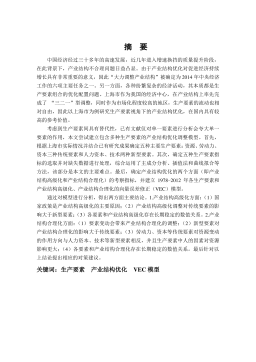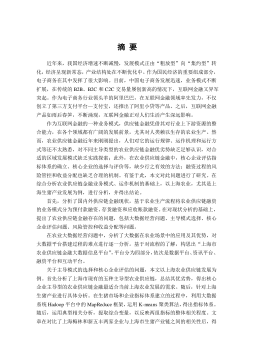公立医院经济行为分析及资源整合研究
摘要本文对国内医疗卫生改革、医院产业化倾向、医院经济行为和公立医院资源整合文献进行了回顾,深入研究了我国公立医院所处的制度环境和其主体特性,重点分析了医院产业化倾向问题和医院资源整合参与主体的行为,重新认识医疗卫生系统的特殊性以及公立医院在我国所处的特殊位置和特殊作用。本文认为,前一时期医疗卫生体制改革中之所以出现了医院产业化倾向,是由于改革管理层和理论界有意或无意地将公立医院视为了社会性企业,而且过分强调了其“企业性”所致。为此,本文从社会性企业的角度对公立医院在该阶段经济行为及资源整合进行分析。本文认为对公立医院的研究及其行为分析,既不能把它当成只追求利润而不考虑社会公益性的企业来看待,也...
相关推荐
-
我国基层财政困难的制度成因分析与对策研究VIP免费

 2024-09-20 33
2024-09-20 33 -
我国煤电产业链纵向交易合约机制研究VIP免费

 2024-09-20 28
2024-09-20 28 -
生产要素视角下的上海市产业结构优化研究VIP免费

 2025-01-09 7
2025-01-09 7 -
我国银行业结构与经济结构关系研究VIP免费

 2025-01-09 7
2025-01-09 7 -
大数据视角下农业供应链金融研究VIP免费

 2025-01-09 6
2025-01-09 6 -
跨国大型综合超市的规划研究VIP免费

 2025-01-09 6
2025-01-09 6 -
跨境电商农产品质量安全问题研究VIP免费

 2025-01-09 7
2025-01-09 7 -
世界市场的虚拟化与我国国际电子商务发展方向研究VIP免费

 2025-01-09 9
2025-01-09 9 -
中国政府对电力行业的价格规制问题研究VIP免费

 2025-01-09 14
2025-01-09 14 -
中小企业信息化系统集成技术研究VIP免费

 2025-01-09 14
2025-01-09 14
相关内容
-

跨国大型综合超市的规划研究
分类:高等教育资料
时间:2025-01-09
标签:无
格式:PDF
价格:15 积分
-

跨境电商农产品质量安全问题研究
分类:高等教育资料
时间:2025-01-09
标签:无
格式:PDF
价格:15 积分
-

世界市场的虚拟化与我国国际电子商务发展方向研究
分类:高等教育资料
时间:2025-01-09
标签:无
格式:PDF
价格:15 积分
-

中国政府对电力行业的价格规制问题研究
分类:高等教育资料
时间:2025-01-09
标签:无
格式:PDF
价格:15 积分
-

中小企业信息化系统集成技术研究
分类:高等教育资料
时间:2025-01-09
标签:无
格式:PDF
价格:15 积分





